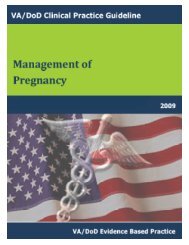DM Full Guideline (2010) - VA/DoD Clinical Practice Guidelines Home
DM Full Guideline (2010) - VA/DoD Clinical Practice Guidelines Home
DM Full Guideline (2010) - VA/DoD Clinical Practice Guidelines Home
You also want an ePaper? Increase the reach of your titles
YUMPU automatically turns print PDFs into web optimized ePapers that Google loves.
Version 4.0<br />
<strong>VA</strong>/<strong>DoD</strong> <strong>Clinical</strong> <strong>Practice</strong> <strong>Guideline</strong><br />
for the Management of Diabetes Mellitus<br />
C. Refer Patient with Type2 <strong>DM</strong> for Initial Eye Retinal Examination<br />
OBJECTIVE<br />
Establish the timing of the initial ocular evaluation for patients with type 2 <strong>DM</strong>.<br />
BACKGROUND<br />
Patients with newly diagnosed type 2 <strong>DM</strong> may have had several years of sub-clinical or clinical diabetes prior to<br />
being diagnosed. Retinopathy can develop during this time and up to 40 percent of patients will have evidence of<br />
diabetic eye disease at the time their diabetes is diagnosed. Although the prevalence of vision threatening<br />
retinopathy at the time of diagnosis is very low, there is a 3-4 percent prevalence of proliferative retinopathy within<br />
the first few years of disease. Consequently, it is recommended that patients with new onset type 2 <strong>DM</strong> who have<br />
not had a dilated eye examination within the prior 12 months should have one performed within 6 months.<br />
RECOMMENDATIONS<br />
1. Patients who are newly diagnosed with type 2 <strong>DM</strong> and have not had an eye exam within the past 12 months<br />
should have a retinal examination performed within 6 months [B]<br />
2. A retinal examination (e.g. dilated fundus examination by an eye care professional or retinal imaging with<br />
interpretation by a qualified, experienced reader) should be used to detect retinopathy. [A]<br />
DISCUSSION<br />
The quality of the eye examination is a critical factor in the ability to detect early retinopathy, thus only qualified<br />
eye care professional or trained readers using validated imaging techniques should be utilized for retinopathy<br />
screening and surveillance. Ophthalmoscopy should be performed through dilated pupils using high magnification<br />
and stereo viewing. Fundus photography is also highly sensitive in detecting clinically significant retinopathy and<br />
when combined with interpretation by an experienced reader, may exceed the sensitivity of ophthalmoscopy in<br />
retinopathy detection. Non-mydriatic digital retinal imaging (i.e. fundus photography through a non-dilated pupil)<br />
also provides excellent sensitivity. In some cases small pupils and/or media opacities will cause image degradation<br />
(Whited et al., 2006). The combination of non-mydriatic digital retinal imaging with referral to an eye care specialist<br />
for patients in whom image quality is sub-optimal is an appropriate screening strategy as it can achieve a very high<br />
level of sensitivity in the detection of retinopathy. In some cases, selective use of mydriatic eye drops to facilitate<br />
improved image quality will enhance the diagnostic utility of digital retinal imaging.<br />
EVIDENCE TABLE<br />
Recommendation Sources LE QE SR<br />
1 Initial Screening for Retinopathy UKPDS 38 1998<br />
I Fair B<br />
in patients with Type 2 Diabetes Javitt et al., 1989, 1994, 1996<br />
who have not had an eye exam<br />
Nathan et al., 1991<br />
within the past 12 months and<br />
are newly diagnosed with type 2 Vijan et al., 2000<br />
<strong>DM</strong> should have a retinal<br />
examination performed within 6<br />
months.<br />
2 A retinal examination (e.g. dilated<br />
fundus examination by an eye<br />
care professional or retinal<br />
imaging with interpretation by a<br />
qualified, experienced reader)<br />
should be used to detect<br />
retinopathy.<br />
Diabetic Retinopathy Study<br />
Research Group 1981<br />
ETDRS Research Group 1993<br />
DCCT Research Group, 1993<br />
Harding SP, BMJ 1995<br />
I Good A<br />
LE-Level of Evidence; QE = Quality of Evidence; SR = Strength of Recommendation (see Appendix A)<br />
Module E – Eye care Page 91
















